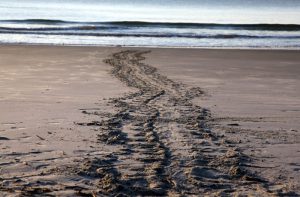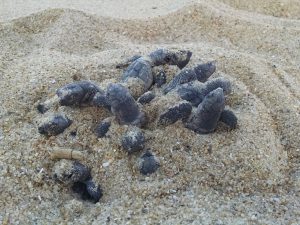Our beaches are full of activity in the summer, and in particular from some of our seasonal visitors- the nesting sea turtles. We are fortunate to be a laying ground for several species of sea turtles, including Kemps Ridley, Green, Loggerhead, Hawksbill and Leatherback. 
Kemps Ridley– One of the smaller species of nesting turtles on the Outer Banks, Kemps Ridley is a critically endangered species. Only 7,000- 9,000 nesting females are estimated to be in existence today. In the summer of 2023, three nests were found on the beaches of the Outer Banks, which will hopefully assist in this species being around for a long time.
Green Turtle– Green turtles are a larger species and can grow to 3 or 4 feet long and weigh up to 350 pounds. Their population is estimated to be between 85,000- 90,000 turtles today, which is still considered a threatened species.
Loggerhead– The Loggerhead is the most common visiting turtle to the Outer Banks. These turtles have large, oversized heads, which lends to the name to crack open some of their favorite hard-shelled crustaceans.
Hawksbill– This critically endangered species traditionally lives in tropical and subtropical climates and does occasionally nest on the beaches of the Outer Banks. The head comes to a pointed shape and their lower jaw is V-shaped, which gives them a hawk appearance.
Leatherback– The largest of all sea turtle species, Leatherbacks earned their name from the rubbery texture of their skin. They can’t chew and prefer to eat things like jellyfish as their main diet.
Nesting season for sea turtles on the Outer Banks is between May 15 and September 15. Specially trained NEST (Network for Endangered Sea Turtles) volunteers check the beach frequently for signs of a nesting sea turtle in order to identify the species, mark the nest and the date of the lay to attempt to know when the eggs will hatch. Sea turtle nests hatch between 45- 70 days, pending the size of the nest and outdoor temps and humidity. 
As a visitor, these nests are marked with beach fencing, some flags and occasionally a sign to alert visitors to the active nest beneath the sand. NEST continues to observe the nest to wait for the boil, which is when the turtles hatch and begin leaving the nest.
Visitors can help the nesting sea turtles on the Outer Banks by doing the following:
1. Eliminate additional outdoor light pollution (the closer to the beach, the more important) as additional lights can confuse the nesting sea turtle and the hatchlings.
2. Fill any deep holes dug on the beach. The holes can hurt the volunteers who are roving and searching for nests and they can also trap the hatchlings and prevent them from getting to the waves for safety.
3. Leave no trace on the beach. After a day of fun in the sun with your crew, be sure to clean up all trash, beach toys, chairs, tents and anything else you brought to the beach. If you see litter, please dispose of it in the nearest trash can.
4. If you bring your pet to the beach, be sure to keep them on a leash to prevent any nest disturbances.
5. Be aware of your surroundings when driving on the beach. The farthest north that sea turtles typically lay their eggs is Carova, or the northernmost part of the The Northern Outer Banks. When traveling on the beach, especially at dusk, evening or daylight, keep your eyes peeled for nesting sea turtles.
6. If you see a nest boil or hatchlings or a turtle in distress, please contact NEST at 252-441-8622.
The turtles are very important to our ecosystem and their survival depends on everyone working together to protect them.
To learn more about the sea turtles on the Outer Banks and the conservation efforts by NEST, click here.

